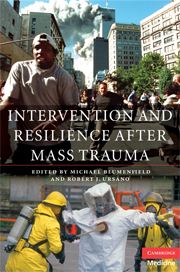Book contents
- Frontmatter
- Contents
- List of contributors
- Foreword by Joseph T. English
- Preface
- 1 Systems, science, and populations: Effective early mental health intervention following mass trauma: the roles of government, clinicians, and communities
- 2 Factors in the development of community resilience to disasters
- 3 Psychological first aid
- 4 Acute stress disorder and early interventions after trauma
- 5 The role of pharmacotherapy in early interventions
- 6 Should culture considerations influence early intervention?
- 7 Resilience is the default: how not to miss it
- 8 Epilog: Early intervention for individuals and communities: planning for the future while meeting present needs
- Index
- References
1 - Systems, science, and populations: Effective early mental health intervention following mass trauma: the roles of government, clinicians, and communities
- Frontmatter
- Contents
- List of contributors
- Foreword by Joseph T. English
- Preface
- 1 Systems, science, and populations: Effective early mental health intervention following mass trauma: the roles of government, clinicians, and communities
- 2 Factors in the development of community resilience to disasters
- 3 Psychological first aid
- 4 Acute stress disorder and early interventions after trauma
- 5 The role of pharmacotherapy in early interventions
- 6 Should culture considerations influence early intervention?
- 7 Resilience is the default: how not to miss it
- 8 Epilog: Early intervention for individuals and communities: planning for the future while meeting present needs
- Index
- References
Summary
Introduction
This paper discusses three main themes that need to be addressed for effective early intervention.
The first is the examination, through a systems analysis, of the factors that may impact on mental health through formal and informal organizational activity and behaviors, in the prevention, preparation, response, and recovery to disasters and terrorism.
These systems may be vehicles to support positive mental health outcomes, or may contribute to vulnerability; the identification and mobilization of these are critical for early intervention and more specifically for good mental health outcomes. Such factors may far outweigh the efforts of individual clinicians and specialist mental health programs, despite their valuable contributions overall.
The second is a more thorough examination of the science of early intervention, its conceptualization and current scientific underpinnings and rationale, and the necessary components of an effective early intervention strategy to inform the mental health response to mass emergencies.
Thirdly, it will draw together these elements in a template for the delivery of “early intervention.” This review will highlight the significant further work that is needed to both build the scientific base and to translate it into real world policy and services for affected populations. This requires government and organizational support to lead to the delivery of effective early intervention across the range of potential disaster and terrorism scenarios.
Systems and early intervention
There is a growing interest in systems and complex systems – systems in fields as diverse as molecular biology, information systems, emergency and the military organizations, health care systems, and many others.
- Type
- Chapter
- Information
- Intervention and Resilience after Mass Trauma , pp. 1 - 48Publisher: Cambridge University PressPrint publication year: 2000



